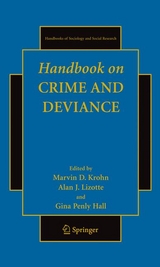Handbook on Crime and Deviance
Springer-Verlag New York Inc.
978-1-4419-0244-3 (ISBN)
- Titel erscheint in neuer Auflage
- Artikel merken
The eldofcrimeanddevianceisextensiveandevergrowing. Asinglecollectionofarticles couldnotcapturethevariousmethods,theories,andissuesthatcomprisethekeyconcernsofthe discipline. Facedwiththevastarrayofpotentialtopicareasthatcouldbelegitimatelyincluded insuchacompendium,wedecidedtouseourownlenstofocusonareasthatwedeemtobeof continuingimportanceandthoseinwhichimportantdevelopmentshaveemerged. Althoughwe recognizethatmuchhasbeenexcludedfromthiscollection,wethinkwhathasbeenincorporated shouldbeofgreatinteresttoscholarsworkinginthe eldandtothosestudentswhoarebecoming acquaintedwithit. Thecompendiumisdividedintofourmajorsections:(1)MethodologicalIssuesinCrime Research;(2)ExplanationsofCrime;(3)CriminalJustice-RelatedIssues;and(4)SpecialTopics inCrime. Withineachsection,wehaveendeavoredtoselectauthorswhoaremajor guresin theareaonwhichtheywriteorareamongthoseyoungscholarswhoaredoingsomeofthe mostimportantworkintheirareasofexpertise. Thisblendofseniorandup-and-comingscholars demonstratesthecontinuingvitalityofthe eldandwehopethatvitalityemanatesfromthe selectionswehavechosen. PartItitled"MethodologicalIssuesinCrimeResearch"containsfourchapters.
Theissues thataredealtwithrangefromthosethatarethesourceofcontinuingdebate(arelongitudinal designsworththeexpenseandeffort,anddothebene tsofcomparativestudiesoutweighthe dif cultiesinconductingthem)aswellasissuesthatareonthecuttingedgeofcriminolo- calresearchtoday(theuseofgroup-basedstatisticalmethodologyforanalyzingdevelopmental trajectoriesandtheuseofincident-basedreportingsystems). A Handbook on Crime and DeviancewouldcertainlynotbecompletewithoutaPartII titled"ExplanationsofCrime. "Wehavenotincludedachapteroneverytheoreticalperspective thathasbeenpartofthedisciplinarydialogue. Rather,wehaveselectedsomeofthetheories onwhichtherehasbeensigni cantdevelopmentoverthepast10years. Theauthorswhohave contributedchaptersareclearlyamongthosewhoarecurrentlydoingworktoadvanceeitherthe theoreticaldevelopmentofthoseperspectivesortheresearchagendaonthosetheories,orboth. v vi Preface Theyalsowereinstructedtoemphasizethemorerecentdevelopmentsoftherespectivetheories intheirexpositions. PartIIIcontainschaptersaddressing"CriminalJustice-RelatedIssues. "Thereweream- iadofissuesthatcouldhavebeenaddressedinthispart. Wechosetoseekcontributionsonissues thatrelatetheorytopractice.
Althoughweseparatethemfromourtheorysection,thesesel- tionscouldhaveeasilybeenincludedthere. Wealsoincludedessaysontwoissuesthatcontinue tobeamongthosethatareofcontinuingconcern,capitalpunishment,andthein uenceofrace andsexintheprocessingofoffendersinthecriminaljusticesystem. Part IV of the Handbook, "Special Topics in Crime and Deviance", is a compilation of issuesthatcontinuetobeorhavebecome'hottopics'inour eld. Theyrangefromgangs,guns, peers,anddrugstoissuessuchaschildabuseanddomesticviolence,cybercrime,andhatecrime. Thereareexcitingtheoreticalandresearchdevelopmentsintheseareas,manyofwhichhavebeen forwardedbytheauthorsofthesechapters. WhenrepresentativesofSpringeraskedustoassembleacompendium,theyspeci cally instructedustoselectarticlesbasedonourvisionofwhatwashappeninginthe eldtoday. Wehaveendeavoredtodothat. Moreimportantly,insolicitingchaptersfromthecontributing authors,weaskedthemtorelyontheirviewofwhatwasofparticularcurrentinterestintheir areaofexpertise. Wefurtherencouragedthemtoincorporatetheirownworkintheseareasin ordertotakefulladvantageoftheirexpertise.
Theresultisacompendiumthatincludesan- to-dateassessmentofthestateofthe eldonanumberofextremelyimportanttopicsincrime anddeviance. Wethinkitwillbeavaluableresourcetoestablishedscholarsaswellasstudents whoarebeingintroducedtothe eld. MARVIN D. KROHN Contents I. METHODOLOGICAL ISSUES IN CRIME RESEARCH Alan J. Lizotte 1. Contributions of Cross-National Research to Criminology at the Beginning of the 21st Century ...3 Janet P. Stamatel Introduction...3 WhatDoesCross-NationalCriminologyMean? ...4 TheValueOfCross-NationalCriminology...5 AskingDifferentQuestions...6 Macro-levelExplanations...7 ContextualizingCrimeinTimeandSpace ...8 MethodologicalChallengesAndNewDevelopments...9 QuantitativeApproaches ...9 QualitativeApproaches ...12 TheoreticalChallengesAndNewDevelopments ...13 GrandTheories ...14 AdaptingIntra-nationalTheoriestotheCross-NationalSetting ...15 NewDirectionsforCross-NationalCrimeTheories ...16 Conclusions...18 References ...18 2. Studying the Crime Problem with NIBRS Data: Current Uses and Future Trends ...23 Lynn A. Addington Introduction...23 OverviewOfNIBRS ...24 OriginsofNIBRSandInitialGoalsforIncident-BasedCrimeData...24 InformationCollectedbyNIBRS...2
5 vii viii Contents LawEnforcementParticipationinNIBRS...28 CurrentUsesOfNIBRSDataToResearchCrime...30 EarlyUsesofNIBRSData...30 ExamplesofCurrentUsesforNIBRSData ...30 ChallengesToUsingNIBRSData ...34 Challenge1:ConcernswithDataQuality ...34 Challenge2:LimitationswithPolice-GeneratedCrimeData ...35 Challenge3:AnalyticalComplexityofNIBRSData ...35 FutureTrendsInUsingNIBRSDataToStudyCrime ...35 AddressingChallenge1:ConcernswithDataQuality ...36 AddressingChallenge2:LimitationswithPolice-GeneratedCrimeData ...38 AddressingChallenge3:AnalyticalComplexityofNIBRSData...39 Conclusion...39 References ...40 3. Longitudinal Data and Their Uses...43 Alan J. Lizotte, David McDowall, and Nicole M. Schmidt Introduction...43 TheRochesterYouthDevelopmentStudy ...44 Data...44 Measures...44 Cross-SectionalVersusLongitudinalData ...46 ExamplesofDifferencesBetweenCross-SectionalandLongitudinal Analyses ...46 Conclusions...56 References ...
Marvin Krohn is the Associate Dean of the School of Criminal Justice at the State University of New York at Albany. He was previously on the Executive Council of the American Society of Criminology and was an associate editor for Criminology. Alan Lizotte is a Professor in the School of Criminal Justice at SUNY Albany and the Executive Directro of the Hindelang Criminal Justice Research Center also at SUNY Albany
Methodological Issues in Crime Research Introduction.- Contributions of Cross-National Research to Criminology at the Beginning of the 21st Century.- Studying the Crime Problem with NIBRS Data: Current Uses and Future Trends.- Longitudinal Data and Their Uses.- Group-Based Modeling: An Overview.- Explanations of Crime Introduction.- Biosocial Criminology.- The Social Learning Theory of Crime and Deviance.- Self-Referent Processes and the Explanation of Deviant Behavior.- Self-Control Theory: Research Issues.- General Strain Theory.- Labeling Theory.- Institutional Anomie Theory: A Macro-sociological Explanation of Crime.- Social Disorganization Theory: Then, Now, and in the Future.- Criminal Justice – Related Issues Introduction.- Deterrence and Decision Making: Research Questions and Theoretical Refinements.- Situational Crime Prevention: Theoretical Background and Current Practice.- Desistance from Crime.- The Flow and Ebb of American Capital Punishment.- The Joint Effects of Offender Race/Ethnicity and Sexon Sentencing Outcomes.- Knowledge to Practice or Knowledge of Practice? A Comparison of Two Approaches to Bringing Science to Service.- Special Topics in Crime and Deviance Introduction.- Peers and Delinquency.- The Many Ways of Knowing: Multi-Method, Comparative Research to Enhance Our Understanding of and Responses to Youth Street Gangs.- Developmental Sequences and Comorbidity of Substance Use and Violence.- Caught in a Crossfire: Legal and Illegal Gun Ownership in America.- Family Violence and Delinquency.- Hate Crimes: Perspectives on Offending and the Law.- Cybercrime.
| Reihe/Serie | Handbooks of Sociology and Social Research |
|---|---|
| Zusatzinfo | 40 Illustrations, black and white; XVIII, 602 p. 40 illus. |
| Verlagsort | New York, NY |
| Sprache | englisch |
| Maße | 178 x 254 mm |
| Gewicht | 1354 g |
| Themenwelt | Recht / Steuern ► Strafrecht ► Kriminologie |
| Sozialwissenschaften ► Soziologie | |
| ISBN-10 | 1-4419-0244-9 / 1441902449 |
| ISBN-13 | 978-1-4419-0244-3 / 9781441902443 |
| Zustand | Neuware |
| Haben Sie eine Frage zum Produkt? |
aus dem Bereich





